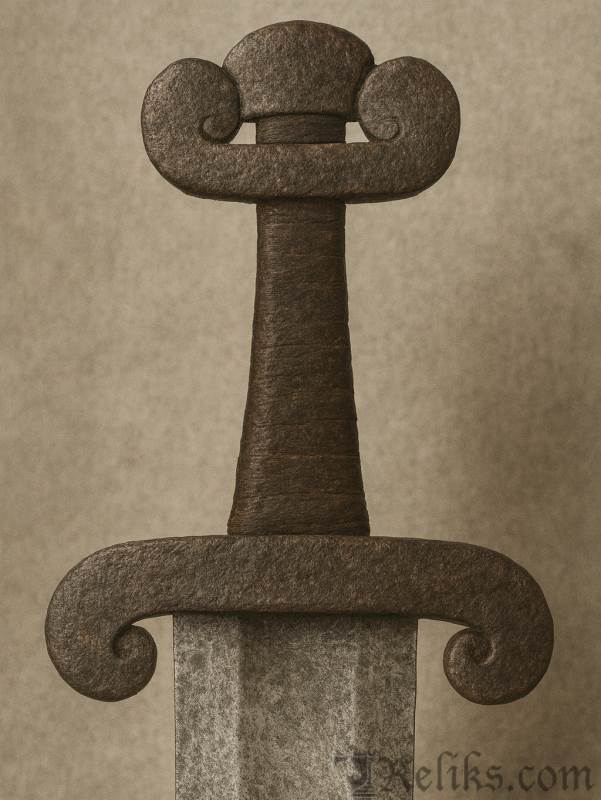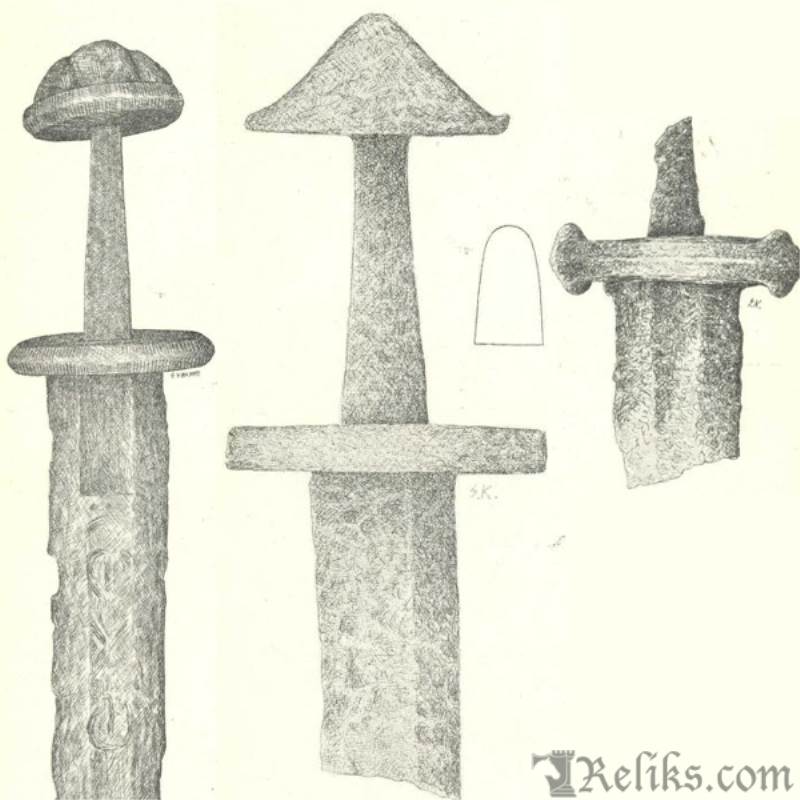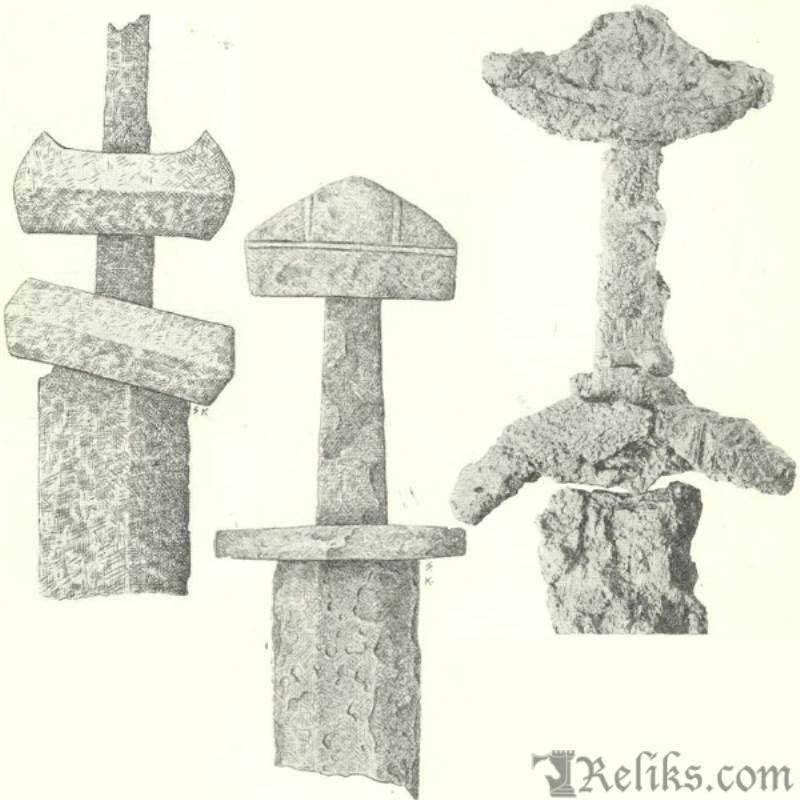Viking Sword Type G – Rare Experiments of the Early Viking Age
A Transitional Curiosity
Unlike Types A–F, which survive in dozens of examples, Type G is exceptionally rare, with only a handful of swords recorded. This scarcity makes it one of the most intriguing groups in Petersen’s typology. The hilts often feature spiral-shaped guards and a small square or polygonal pommel block, a design that looks experimental and transitional.
Because so few examples survive, scholars interpret Type G as a short-lived form, perhaps influenced by older Migration Period hilts or even foreign prototypes. Its rarity and unusual construction give it a special place among the early Viking Age swords.
Archaeological Description

Viking Sword Type G – Rare Experiments of the Early Viking Age
The core Type G group consists of just four main swords:
- Guards: Upper guards bent upwards at the ends, often in a spiral. Lower guards sometimes bend downward in the opposite direction.
- Pommel: Usually a small square knob between the spiral curves, recalling the simple block pommels of Type F. One example shows only a swelling rather than a true block, suggesting degeneration.
- Decoration: None — these swords are undecorated, plain iron.
- Blades: Three are single-edged, one is double-edged.
The combination of spiral guards and block pommels makes them look unusual and “foreign” compared to other Viking swords. Petersen even suggested they might reflect outside influence, though he could not pinpoint the source.
Special Variants (Sub-Types)

Petersen Sketch (fig.71)
Petersen grouped several unusual finds under “special types” related to G” because they don’t fit neatly elsewhere but show similar experimental traits:
- Kvarberg sword (Oppland): Single-edged, narrow blade (only 4.3 cm wide). Guard like Type B, but with raised ends resembling later P-types. Found with an early spearhead and scramasax, confirming its early Viking Age date.
- Brevik sword (Buskerud): Double-edged, with a C-type style upper guard but decorated with grooves suggesting division. Lower guard more like M-type. Associated finds place it around mid-9th century.
- Rimstad sword (Vestfold): Double-edged, richly inlaid with silver plates and damascened blade marks. Pommel a classic three-part form. Likely a degeneration of Migration Period pommels with animal-head sides.
- Kviteseid sword (Telemark): Single-edged, very plain, with triangular pommel functioning almost as the entire upper guard. Considered early, possibly 8th–9th century.
- Bergsviken sword (Telemark): Double-edged, lower guard with small hemispherical knobs imitating old bronze rivet-heads. Another sign of old features simplified into new Viking forms.
- Jølster sword (Sogn): Double-edged, large curved guards and a tall pommel rising to a peak. Looks like later types Y or Z, but found with C–D swords and E-type spears, placing it in the first half of the 9th century.
Together, these variants show how smiths experimented with form, blending features of Types B, C, D, and even foreshadowing later curved-guard swords.
Historical & Cultural Context

Petersen Sketch (fig.72-74)
Type G and its variants belong to the earliest Viking Age, mostly the first half of the 9th century. They are closely related to the evolution of Types B and C but diverge in unusual ways, perhaps reflecting local smiths trying out foreign-inspired designs.
The strong presence of single-edged blades among G-types ties them back to the older Scandinavian scramasax tradition, while their rare occurrence suggests they were never mainstream.
Distribution and Finds
The G-type swords are represented by only four confirmed examples, all originating from eastern Norway, specifically in the regions of Oppland and Buskerud. Variants of this type have also been identified in Telemark, Vestfold, Sogn, and Oppland. While no direct parallels have been securely established outside of Norway, certain similarities can be observed with forms from Gotland and parts of the continent. The associated finds often include early spearheads of the B- and F-types, axes of transitional form, shield bosses of the R 564 variety, and early oval brooches such as the R 648. Taken together, these associations point to a dating in the early 9th century, though some specimens may have remained in use slightly later.
For Collectors and Enthusiasts

Petersen Sketch (fig.75-77)
Type G swords are virtually unknown in the replica market because of their rarity and oddity. Yet, they are crucial for understanding Viking sword development. They represent “roads not taken” in sword design — experiments in combining spiral guards, block pommels, and simplified ornaments that did not become dominant.
For enthusiasts, Type G provides a fascinating glimpse of the fluidity of early Viking craftsmanship, where innovation sometimes produced dead ends, but also set the stage for later, more successful designs.
Closing Reflection
Type G may not have the elegance of Type D or the heft of Type C, but it speaks volumes about Viking smiths exploring new ideas. With only a handful of surviving examples, it is one of the rarest and most enigmatic categories in Petersen’s typology — a reminder that Viking swords were not just weapons, but evolving experiments in form and function.
Core classification based on Jan Petersen, De Norske Vikingesverd (1919). Additional commentary by Reliks.com.